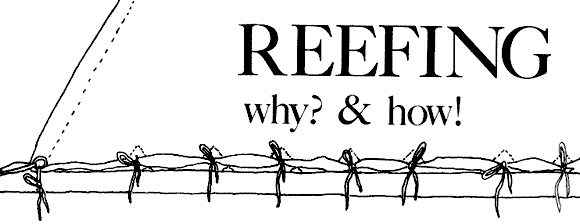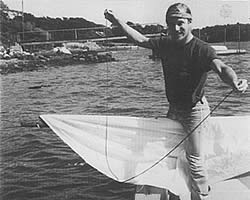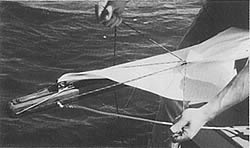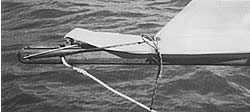
As we all know from experience, Beetle Cats sail best in light and moderate winds which Mishaum doesn't always accommodate. When the commodore determines that the fleet must reef, it is helpful for everyone to know how to do it. It is not that hard.
Howard I. Chapelle once said that "modern yachtsmen have developed an allergy against reefing." (The Catboat Book) Many exceptions to this statement can certainly be found, but as a whole, Beetle Cat sailors are unquestionably one of the most "allergic" groups around. The prevailing attitude among Beetle Catters is that reefing is for sissies, while the prevailing practice (except for scheduled races) is not to go sailing if it gets too windy. This is a rather unfortunate situation for a couple of reasons.
 Properly reefed and beautiful. |
First of all, Beetle Cats, like their big sister the Cape Cod Cats, handle very nicely in rough weather when reefed. While this is not an economic necessity for today's recreational sailors, it is still a nice plus as it can really extend the range of conditions considered enjoyable for pleasure sailing. As Stan Grayson puts I in his book Catboats, "The difference [between an un-reefed and reefed catboat] will be a choice between a helm that is barely if at all controllable with two strong arms, and a docile helm that can be attended by one untrained hand, or even two fingers."
Secondly, Beetles sail beautifully in heavy weather when reefed. Any boat with a well-designed sail properly reefed, not only handles better, it also goes just as fast as an un-reefed boat. In technical terms. The reason for this is that Beetles, like all non-planing boats, have an upper speed limit known as "hull speed" which can be calculated using the following formula:
Hull speed in knots= 1.33 times the square root of the waterline length in feet.
In practical terms, what this means is that the boat will go just so fast, and not faster, so carrying more sail than necessary to maintain this speed is, at best, a waste of power and at worst, a source of handing difficulties and possible breakage.
Everything You Always Wanted to Know About Reefing (But Were Afraid to Ask)
On boats without topping lifts (most Beetle fall into this category), reefing is done with the sail down. Before starting to tie in a reed, make sure the sail is bent onto the spars ready for normal, un-reefed sailing (everything attached, outhauls tight). Then follow these three steps:
1. Inhaul - Tie the reefing grommet in the luff down to the tack
grommet or gooseneck fitting with a short piece of line using a reef knot.

2. Outhaul - Tie the reefing grommet in the leech to the boon in tow directions: first out to the end of the boom. Be sure to pull it out tightly. Second, down to the boom directly under the reefing grommet.
3. Reef Points - Roll up the fold of sail between the boom and the reef points and tie the reefing lines by passing them between the foot of the sail and the boom (do NOT pass the reef line around the boom). Be sure to use reef knots.
Keys to Success
   |
- Thread one end of piece of 6-8 foot line though the leech reefing
grommet so that half the line is sticking out on each side of the sail.
- Thread the ends of the line through the hole in the end of the boon
(or the outhaul fitting or clew grommet) in opposite directions.
- Tighten out the luff grommet by pulling on both ends of the line at
the same time.
- Pass the ends of the line back through the luff grommet in opposite directions and then down around the boom. Secure with a reef knot.
This article first appeared
in the 1985 Yearbook of the New England Beetle Cat Boat Association and has
been slightly edited and updated as it appears here.
Copyright © 2001 Jennifer Kano